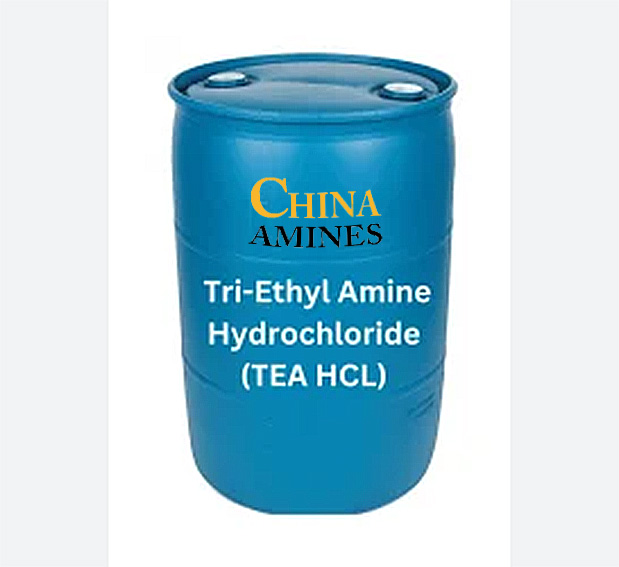1. Chemical Structure and Properties
Molecular Formula: C₆H₁₆ClN
Structural Formula: (CH₂CH₃)₃N·HCl
A tertiary amine hydrochloride formed by neutralizing triethylamine (TEA) with hydrochloric acid.
Physical Properties:
Appearance: White crystalline powder or hygroscopic solid.
Melting Point: 258–262°C (decomposes).
Solubility: Highly soluble in water (>500 g/L at 25°C), ethanol, and methanol; insoluble in non-polar solvents.
Odor: Odorless (unlike volatile TEA gas).
Hygroscopicity: Absorbs moisture rapidly; requires airtight storage.
Chemical Properties:
Stability: Stable under dry conditions; decomposes upon heating to release TEA gas and HCl.
Reactivity: Acts as a weak acid (pKa ≈ 10.75); regenerates TEA when treated with strong bases.
2. Industrial Applications
Pharmaceuticals:
- Intermediate in the synthesis of local anesthetics (e.g., lidocaine) and antihistamines (e.g., tripelennamine).
- Salt Formation: Enhances solubility and stability of APIs (e.g., epinephrine hydrochloride).
Agrochemicals:
- Herbicide precursor: Used in atrazine and glyphosate production.
- Fungicide intermediate: Applied in triazole fungicide synthesis (e.g., tebuconazole).
Organic Synthesis:
- Catalyst: Promotes alkylation, acylation, and nucleophilic substitution.
- Surfactant precursor: Forms quaternary ammonium salts used in detergents and softeners.
Electronics:
- Etching Agent: Removes residues on silicon wafers during semiconductor fabrication (e.g., 3nm node by TSMC).
3. Safety and Toxicology
Health Hazards:
- Potential liver/kidney toxicity (limited data); not classified as carcinogenic (IARC).
- Skin/Eye Contact: Causes irritation and burns (rabbit skin LD50 ~800 mg/kg).
- Inhalation: Dust or decomposition fumes irritate respiratory tract; treat as TEA exposure.
- Ingestion: Moderately toxic (oral LD50 rat: ~1,800 mg/kg); causes GI tract irritation.
Handling Precautions:
- PPE: Nitrile gloves, protective goggles, and N95 respirator recommended.
- Storage: Store in airtight containers under cool, dry conditions; avoid exposure to bases.
- First Aid: Flush exposed areas thoroughly with water; seek medical attention for serious contact.
4. Environmental and Regulatory Compliance
Environmental Impact:
- Aquatic Toxicity: LC50 (fish, 96h): 300–600 mg/L; EC50 (daphnia): 150–300 mg/L.
- Biodegradability: Readily biodegradable (OECD 301D: >70% in 28 days).
- Persistence: Low due to hydrolysis in aqueous environments.
Regulatory Frameworks:
- GB 13690-2009 (China): Classified as General Chemical; adhere to standard protocols.
- OSHA (USA): No established PEL; subject to general dust control requirements.
- EPA: Listed in TSCA Inventory.
- CLP (EU): Classified as Skin Irrit. 2 (H315), Eye Irrit. 2 (H319), Acute Tox. 4 (H302).
- REACH (EU): Fully registered with SDS and disposal requirements.
Transport:
- UN Number: Not classified as hazardous; may be shipped as non-dangerous goods (non-DG).
5. Case Studies and Application Insights
Case 1: Lidocaine Synthesis
- Process: TEA HCl reacts with 2,6-xylidine and chloroacetyl chloride to form lidocaine hydrochloride.
- Efficiency: 90% yield at 60°C using catalytic acid (based on Pfizer's optimized batch process).
Case 2: Semiconductor Wafer Cleaning
- Application: Samsung employs TEA HCl in advanced lithography steps to remove photoresist residues.
- Performance: Achieves 99.5% residue purity removal with minimal etching on delicate substrates.
Comparative Analysis:
- Pros: Non-flammable solid form improves safety and simplifies storage/transport.
- Cons: Requires base treatment to liberate TEA in reactive synthesis applications.


